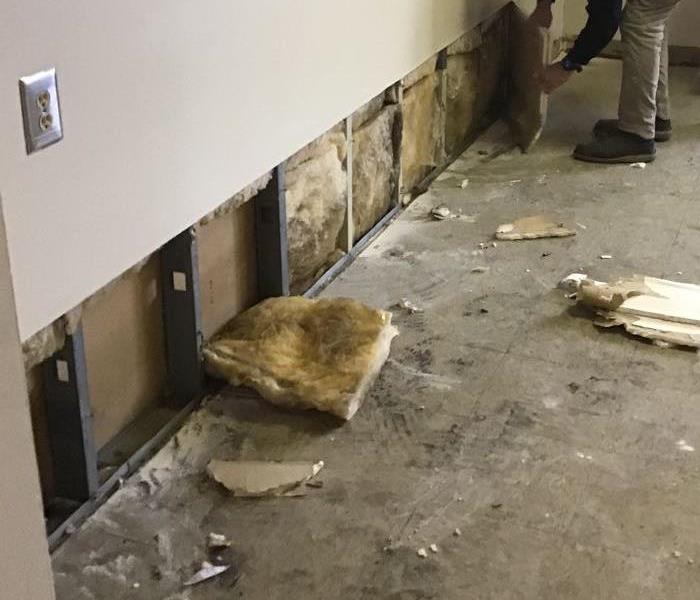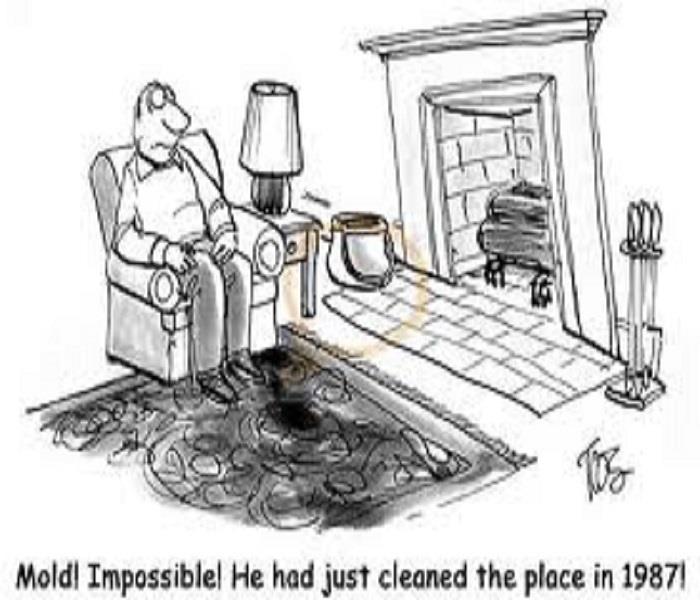Finding and Fixing Mold in Insulation
11/10/2024 (Permalink)
 If you suspect mold in your insulation, it’s always best to call professionals to handle it safely.
If you suspect mold in your insulation, it’s always best to call professionals to handle it safely.
Mold can grow in some unexpected places, and one of the trickiest spots is inside your home’s insulation. Since insulation is hidden behind walls, ceilings, or floors, mold can spread without you even realizing it. If mold gets into your insulation, it can lead to structural issues and bad odors. In this blog, we’ll share some expert advice on how to spot and deal with mold in insulation, as well as how to prevent it from happening in the first place.
How Does Mold End Up in Insulation?
Insulation, whether it's fiberglass, foam, or cellulose, can soak up moisture if there’s a leak or condensation problem in your home. When insulation gets wet, it becomes the perfect breeding ground for mold. Mold spores are always present in the air, and when they land on damp insulation, they can start growing quickly. Areas like attics, basements, and walls are especially at risk if they don’t have good ventilation or if there's a water leak.
The Environmental Protection Agency (EPA) states that mold can begin growing on wet surfaces within 24 to 48 hours. Once it starts, it can be difficult to stop without professional help.
What to Do If You Find Mold in Your Insulation
If you suspect or discover mold in your insulation, here’s what you should do:
1. Find and Fix the Source of Moisture
The first step in dealing with mold is figuring out where the moisture is coming from. Whether it’s a leaking roof, a burst pipe, or poor ventilation, you need to fix the issue to prevent the mold from coming back. Check for cracks, leaks, or areas where condensation is building up.
2. Remove the Affected Insulation
Unfortunately, once insulation becomes moldy, it's difficult to clean. In most cases, you’ll need to remove and replace the damaged insulation. Mold can grow deep into insulation, making it hard to eliminate. A professional mold remediation company like SERVPRO of High Point can safely remove the affected insulation and prevent mold spores from spreading to other areas of your home.
3. Clean the Surrounding Area
After removing the moldy insulation, the next step is to clean the surrounding areas. Mold spores can settle on walls, floors, and ceilings, so it’s important to clean those surfaces thoroughly. Using mold-killing cleaning products ensures that the mold won’t return.
4. Replace Insulation with Mold-Resistant Materials
When it's time to replace the insulation, consider using mold-resistant materials. Mold-resistant insulation is treated to prevent mold growth, even in damp environments. This can help protect your home from future issues.
Tips for Preventing Mold in Insulation
Preventing mold in your insulation starts with controlling moisture in your home. Here are a few simple ways to keep mold at bay:
- Ventilate properly: Make sure areas like attics and basements have proper ventilation. Good airflow helps prevent moisture buildup.
- Control humidity levels: Use a dehumidifier in damp areas, and aim to keep indoor humidity levels below 50%.
- Fix leaks immediately: Whether it's a leaky roof, window, or pipe, address any water issues as soon as possible to prevent moisture from getting into your insulation.
- Check insulation regularly: It’s a good idea to inspect your insulation, especially in moisture-prone areas, to ensure it’s in good condition.
Call SERVPRO® for Professional Mold Removal
If you suspect mold in your insulation, it’s always best to call professionals to handle it safely. At SERVPRO of High Point, we specialize in mold removal and insulation replacement. Our team will ensure your home is mold-free and protect you from future problems.
Source Containment
12/26/2018 (Permalink)
Source containment may be used to address relatively small areas of mold growth, or in combination with other engineering controls to reduce the amount of spores released and dust generated. Source containment may be used alone when fungal growth is limited to small, visible, controllable areas where no hidden mold growth is anticipated. In areas where there is limited visible mold, and hidden mold growth is anticipated, a more extensive containment is recommended. Source containment methods may also be used within areas of more extensive mold growth in conjunction with other forms of containment. Examples of source containment methods include: taping polyethylene sheeting or using self-adhering plastic on the moldy surface or material before removing; and wrapping, bagging, and securely enclosing moldy contents or materials in 6-mil poly or comparable packaging.
Local Containment
12/26/2018 (Permalink)
Local containment may be used when "moderate levels" of fungal growth are visible or suspected. A structural enclosure can be built to contain the work area and separate it from the unaffected section of a structure. PVC pipe, wood framing, or spring-loaded expansion poles can be used to build an enclosure, which then is covered with an appropriate poly material. Constructing structural support is not always necessary if the isolation barrier can be securely attached to wall and ceiling surfaces. One or two layers of 6-mil polyethylene sheeting may be used to cover the enclosure or to erect isolation barriers. HEPA-filtered air filtration devices are installed to create a negative pressure differential in relation to surrounding areas. For further information, contact the professionals at SERVPRO of High Point.
Prevention Strategies
12/26/2018 (Permalink)
Fix leaks immmediately. Clean and dry wet or damp spots immediately. Remove mold-contaminated materials. Regularly inspect and maintain heating, ventilating, and HVAC systems. Routinely inspect and clean HVAC drip pans, check power flow and that drain is unobstructed. Maintain low indoor humidity, ideally 30-60%. Vent moisture-generating equipment to the outside, where possible. Increase surface temperature by reducing the humidity to prevent condensation that results when surface temperature is below dew point temperature. Keep gutters and downspouts in working order and ensuring that they drain water away from the foundation. Remove wet, absorbent structural items and cloth furnishings if they cannot be easily and thoroughly cleaned and dried within 48 hours. Replace with new materials as soon as the underlying structure is thoroughly dry.
Reducing Mold In Your Property
10/19/2018 (Permalink)
Molds are found in every environment, and mold spores reproduce rapidly when moisture is present. One study found that excessive dampness indoors encourages the growth of molds and other organisms, causing a public health problem. The EPA advised that the potential health concerns from molds are an important reason to prevent moisture problems leading to mold growth. It is especially important to clean up existing indoor mold growth to increase property value and retain its value. If a property has experienced a water intrusion, SERVPRO of High Point can inspect the damage to see whether moisture has penetrated materials or is allowing mold growth. Organic materials found inside a property, such as wood, paper, drywall and insulation, provide food sources for mold to flourish. Be diligent in your efforts to keep mold from growing within your property.
Remember – Green Means Clean!
4/7/2016 (Permalink)
If it has been a while since you have completely cleaned your home, there may be some surprises awaiting you. If you discover Mold please make sure you have it cleaned up by a professional company who specializes in Mold Remediation. It’s not just your home…it’s also your health that can be at risk. So call SERVPRO of High Point with the confidence that SERVPRO Green Means everything is Clean! SERVPRO of High Point follows IICRC standards and we make sure that all of our products are in line with these standards. Mold can be the result of a water intrusion that exists in the wall cavity and is not visible to you. Make sure if you have any musty odors present, that you call a trained professional.






 24/7 Emergency Service
24/7 Emergency Service
